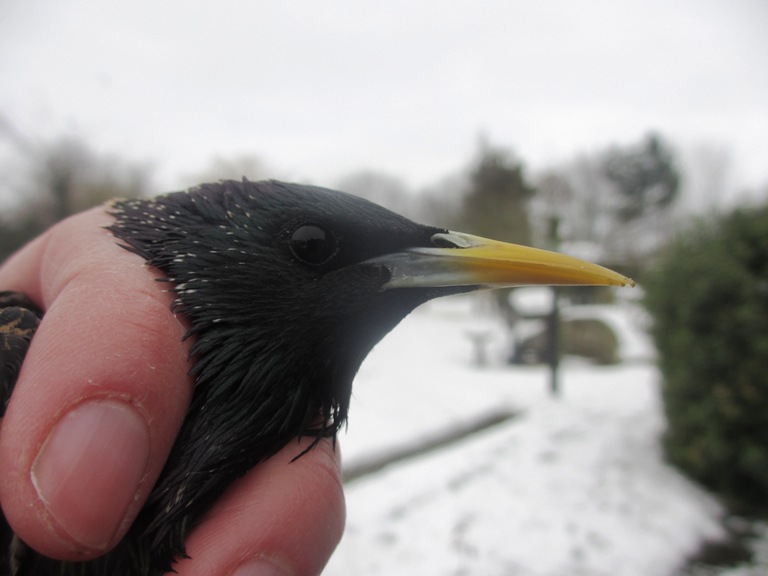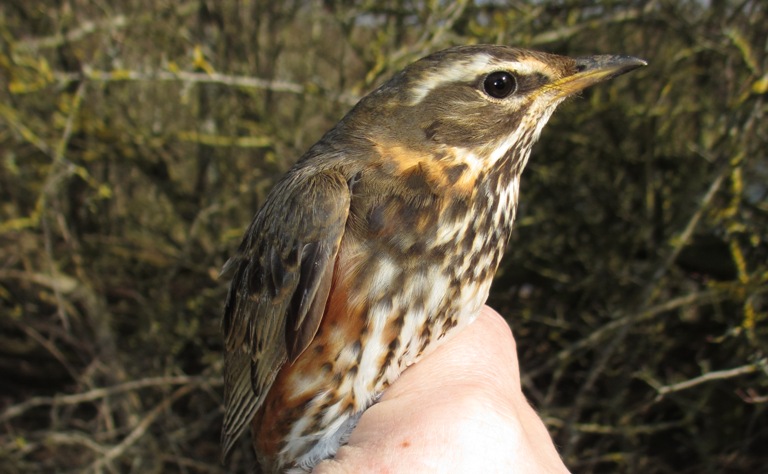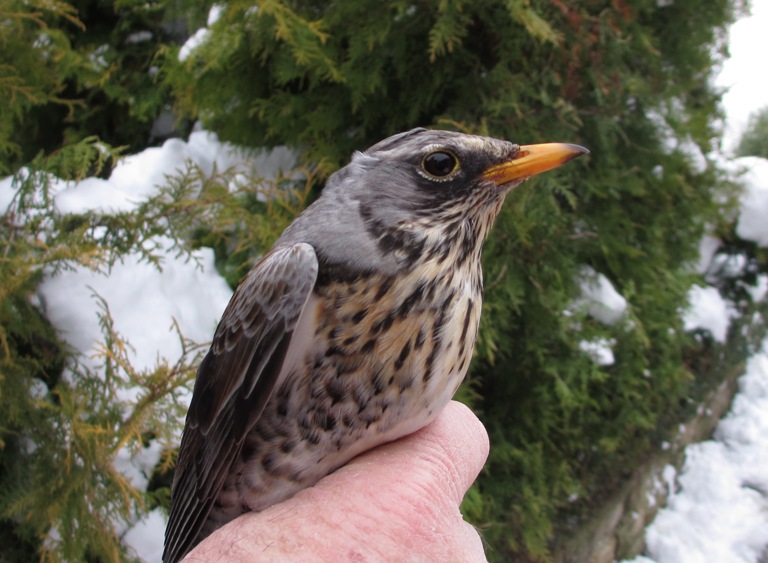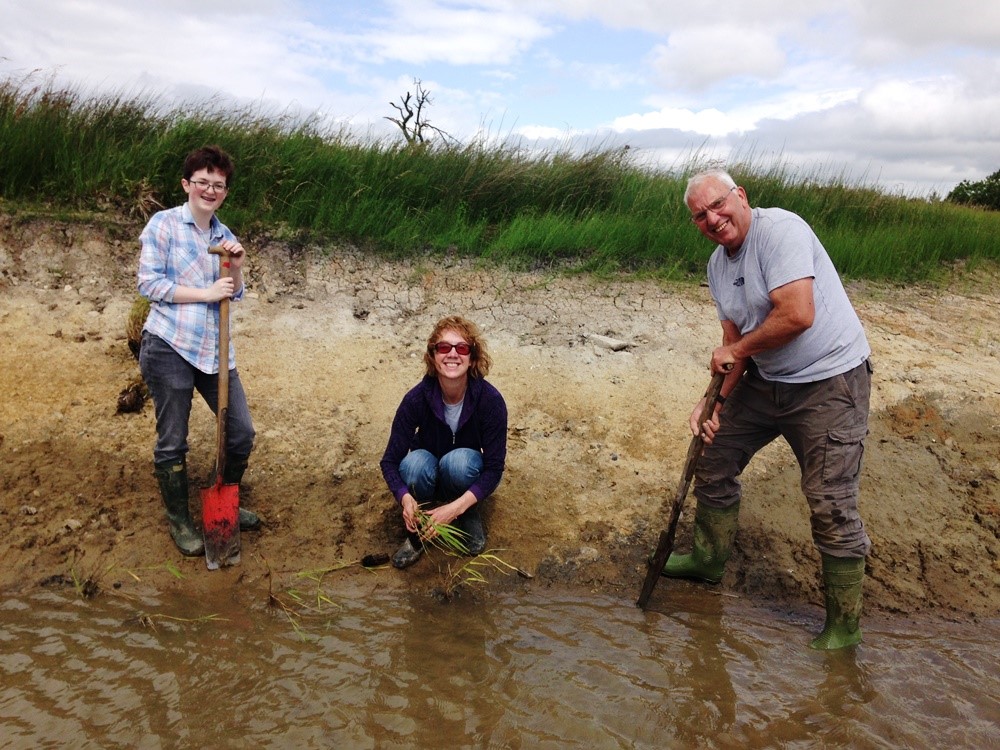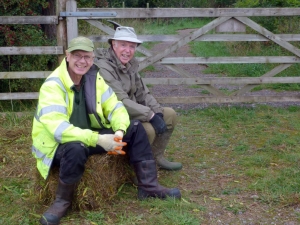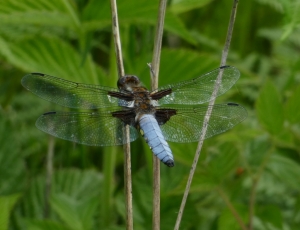Blog Archive (33) Posts Made in March 2018
A Good Friday
Friday, March 30th 2018
Despite the unpromising start due to the heavy overnight rain, today has proved to be a good Friday. We have an Easter Walk laid out around the Reserve with pictures of eggs and rabbits tied to trees and benches, with a set of clues available for this in the Activity Room of the Field Centre.
We have been fortunate to have two of the volunteers in today with Jenny catching up on the 'Friends of Foxglove' and the '100 Club'.

Colin has been in to fill the feeders ready for any bird ringing taking place over the weekend. Given the rate at which some of the birds empty the feeders, they may need replenishing before any ringing takes place. One visitor asked me what the little 'hutches' were, so was given a guided tour of how a net ride works including use of the hoppers to attract the likes of Bullfinches. The Field Centre garden has seen an impressive amount of Chaffinches today, as well as Bramblings, Siskins, Redpolls and Reed Buntings.
.jpg)
While talking to Colin in the Field Centre Garden this morning, we were treated to a male Sparrowhawk flying through and banking round no more than an arm's length away from us as it sped off into the trees.
Continuing with work on replacing cable ties with the broader tree ties for staked trees has been the task of the afternoon. These will put less pressure on the trees, although in most cases the ties are quite loose to allow the tree to move to help in developing the root system.
Some judicious pruning of overhanging trees will help the younger trees get to the light. One young Oak has been so over-shadowed that it has started growing parallel to the ground to seek the sun. The removal of a few small stems above it should mean that it can now start growing upwards again.
.jpg)
Not far from here, two Little Grebe were seen on the Lake and a Chiffchaff was heard, seen and then photographed. After the quick dash by the Frogs to spawn a couple of weeks ago, we have been waiting for the Toads to appear.

This is not a good picture as the camera couldn't focus quickly enough, but there are now several male Toads in the Scapes, waiting for the females to arrive. Let's hope that the snowy weather predicted for Monday isn't too bad.
Warmer Days - For the Moment…
Thursday, March 29th 2018
If you ignore the weather forecast for the next few days you really can start to convince yourself that Spring has arrived. Both Lark and Taurus have started to shed the longer hair of their winter coats as they start to prepare for the warmer weather. Any early frost was quickly melted by the sun and, even early on in the morning, it was warm and sunny along Risedale Beck.

The change in the number of plant species in areas that are touched by the sun has been quite dramatic over the past few days. The south-facing banks above the beck were barely showing the leaves of Primroses last week but are now showing growing numbers of flowers.

On the Wetland, bird activity is increasing including one Mallard drake driving off another pair who had settled on his patch to see if it had potential as a nesting site. He was none too subtle in letting them know the site was already taken. Meanwhile a Greylag Goose spent a long time with his head just above or occasionally below the water line, although it wasn't immediately obvious what had got his attention.


Elsewhere a female was busy very carefully arranging leaves among a patch of reeds and settled down on to these. Despite the pleasant south-facing aspect as she sat with her head into the sun, this clearly didn't live up to expectations as later the pair had moved on to look at other options further into the Wetland. They may have time to be choosy now but competition for nest sites is likely to increase in the near future.
Warmer Days - For the Moment…
Thursday, March 29th 2018
If you ignore the weather forecast for the next few days you really can start to convince yourself that Spring has arrived. Both Lark and Taurus have started to shed the longer hair of their winter coats as they start to prepare for the warmer weather. Any early frost was quickly melted by the sun and, even early on in the morning, it was warm and sunny along Risedale Beck.

The change in the number of plant species in areas that are touched by the sun has been quite dramatic over the past few days. The south-facing banks above the beck were barely showing the leaves of Primroses last week but are now showing growing numbers of flowers.

On the Wetland, bird activity is increasing including one Mallard drake driving off another pair who had settled on his patch to see if it had potential as a nesting site. He was none too subtle in letting them know the site was already taken. Meanwhile a Greylag Goose spent a long time with his head just above or occasionally below the water line, although it wasn't immediately obvious what had got his attention.


Elsewhere a female was busy very carefully arranging leaves among a patch of reeds and settled down on to these. Despite the pleasant south-facing aspect as she sat with her head into the sun, this clearly didn't live up to expectations as later the pair had moved on to look at other options further into the Wetland. They may have time to be choosy now but competition for nest sites is likely to increase in the near future.
Large and Small
Wednesday, March 28th 2018
Not the most interesting of photographs but proof that spring is fighting its way here. Bird Cherry leaves are usually the first to burst their buds and sure enough there was plenty of green just showing through.

Larch has just made it into the March flower list. The red female flowers are beginning to cover the branches.

By the far moor gate only Lark could be seen. Could we have misplaced an Exmoor Pony? A slight brown patch appeared behind the Gorse.

'I'm here!' I think Taurus had spotted us from his hiding place before we spotted him.

Walking down the path a Roe Buck was browsing. His antlers were clear of velvet. He certainly knew we were there but was unconcerned. It was only as we moved off that he decided that he too would amble off.
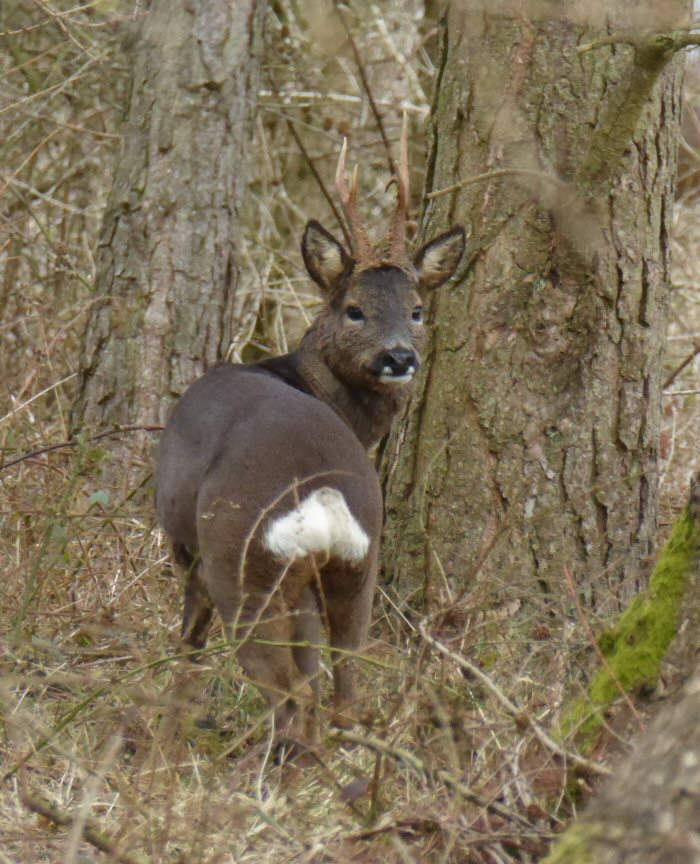
From one of the largest animals on the reserve to one of the smallest, the Mud Snail. We now have five of these tiny snails in a tank in the Activity Room. They enjoy lettuce and Purple Moor Grass, with the occasional drop of fish food once a month.
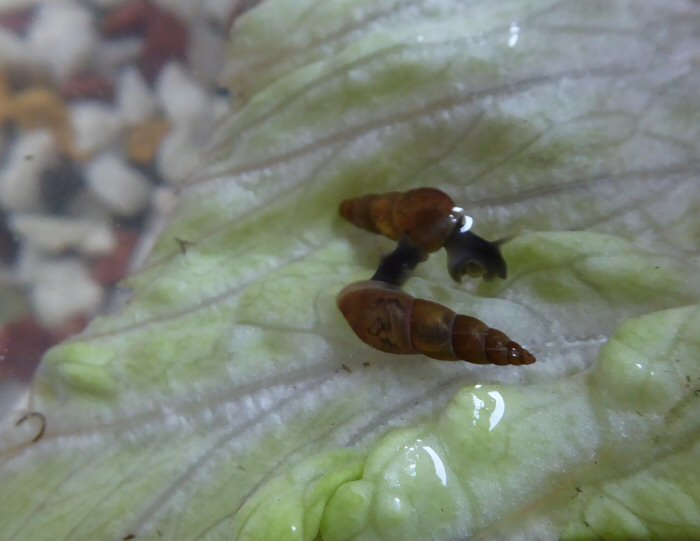
Ann Carter, from the People, Ponds and Water Project brought the snails to us with a poster giving information about these rare snails. They can be found on our wetland.

Leaving the reserve we encouraged this Smooth Newt back into the vegetation, off the road. I hope that we put him on the right side!

Although the night temperatures are low, during the day it may get warm enough to tempt some of the Toads to begin to leave their hibernation sites and start walking back to their ponds. Please take care as you drive along the access road. Thank you.
Net ride 38 completed
Tuesday, March 27th 2018
Today's volunteer task started where I got to late yesterday evening with tidying up the split willow leaning over the path behind the Field Centre.
All in all it's taken around 10 trailer loads to remove brash from the area, with the last 4 being considerably easier thanks to our volunteer task force.
.jpg)
After raking up after ourselves it was time for a quick beverage before getting back to net ride 38.
What we originally thought to be one of the easier net rides to cut has turned out to be one of, if not the hardest to deal with. Every time we've gotten back to tidying I've been amazed at the sheer volume of stuff that we were able to cut down in one day!
After finally getting net ride 38 out of the way there was enough time for a spot of gardening, where we set to planting a whole bag load of Snowdrops Big John brought over from his allotment.
.jpg)
I must now take the time to apologise to Eddie for the above picture which shows him gardening despite him telling his wife that it's been far too wet for such activities of late.
Vexing vegetation
Monday, March 26th 2018
Came across the Roe Deer on my way up to see the ponies this morning. This is becoming a regular occurrence with the group spending a lot of time up that way and becoming braver by the day; today they barely paid me any notice and quickly returned to browsing.

If you couldn't quite spot them in the picture above I'm sure you will in the image below, it's surprising how camouflaged they are despite their white rumps!

Despite not getting anything I had intended to do finished it was a productive day nevertheless, with the entirety of the day spent tidying up fallen and falling vegetation.
There is still a bit of work yet to do on a large willow that has failed at the base and split in many different directions, with some branches leaning towards and over a nearby path.

Carring out any work on a tree such as this requires patience and is made a lot easier when you can remove most of the weight off the branches using a pole saw before making a cut nearer the base of the tree.
Another, nearby issue requiring attention was the tidying up of a long forgotten brash pile blocking light to the forest floor and preventing new spring growth from emerging.
.jpg)
After a lot of effort I was able to remove all of the brash, much of which had rotten down and was buried in earth, and create a more suitable deadwood habitat pile nearby.
.jpg)
We may have got to this job just in time as there were a few shoots trying to push their way clear of the brash pile.
Taking Stock and Tidying Up
Sunday, March 25th 2018
Coming into the Reserve this morning in bright sunshine and light wind made a pleasant change from some of the weather over the past few weeks. Only 7 days ago, the temperature was struggling to get above freezing during the day so being well above that today made it feel like Spring has really arrived. However, the forecast for a return to snow and ice in the middle of the week and potentially for the Easter weekend means that we still have to plan for bad weather.

First on the list of things to do today was take a delivery of hay bales. We now have a good supply for Lark and Taurus if the weather gets really bad, and this gave me a chance to sweep out and tidy the store before stacking the bales. There is clearly some new growth on the Moorland as both ponies were contentedly eating about 100 metres apart from each other and took no notice this morning when I got to the Moorland gate. At first they were happy to carry on grazing before the penny dropped that there might be the odd piece of apple for them.
Thanks to John Graves, one of our volunteers, who came in this morning to fit a new section of pipe to the tap outside the portakabin so that we now have a tap again rather than a fountain, before going for a walk around the Reserve with his wife.

Checking the ponds that had been the scene of busy frog activity last week shows that the spawn laid has survived the frosts of the latter part of last week, with only a few small clumps so far showing signs of being damaged, so most looks like it remains viable.
Walking through Risedale Beck always gives the chance to admire the wonderful Ash trees in this area. There are some beautiful examples of older trees and a favourite is this one, which shows that a tree doesn't need to have all its heartwood to keep on growing. The contrast beween this tree, the young sapling in the foreground and the moss-covered rotting wood between the two almost sums up the life cycle of a tree.

Having cut back a number of net rides, the end products are not only some freshly pollarded trees but also logs and usually a fire site. Now that the fire site in this net ride is cold, the log pile has been moved to cover it over, so that the area where the logs were piled can now grow and the area around the site will grow to cover the edges of the burnt area.


The work on aftercare of trees planted around the Reserve continues. These two Birch trees were leaning at an angle of 45 degrees and were completely filling the tubes they had been planted in. The tubes have now been removed and the trees re-staked using rubber tree ties and, due to the size of the Birch trees, they have been double staked.


Having been out to check the frog spawn earlier in the day, it was a little surprising to return to the Field Centre to find an unusual visitor leaving the building. I can only assume that there had been a need for a quick check of the map to make sure that she was going in the right direction.

We try to keep a record of both volunteers and visitors on the Reserve each day. I'm really not sure which of those two columns on the record sheet I'm going to record this one in.
Ringing At Last
Saturday, March 24th 2018
Ringing can't take place when it is wet and or windy so it was good that the forecast for today showed neither of these. The reserve was noisy as the bird ringers arrived. Birds were singing and the Greylag Geese were having loud conversations! Eventually there appeared to be only two left on the lake and the Mallards had decided to sit on the bank, out of the way.
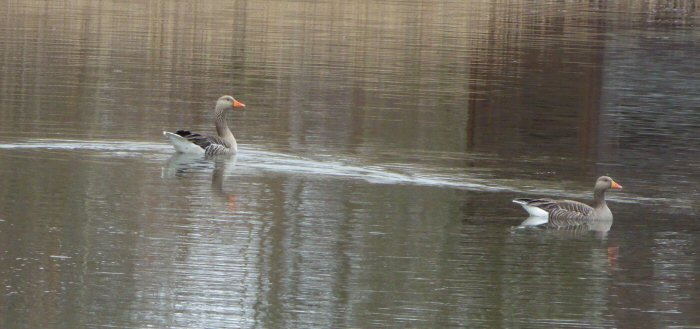
Although the morning was dull there were patches of blue sky. The Scrapes is just beginning to show some spring green, with leaves of Water Figwort, Yellow Flag Iris, Ground Ivy and Forget-me-not pushing through the old vegetation. Even though winter is still holding its grip there are many subtle colours to be seen.
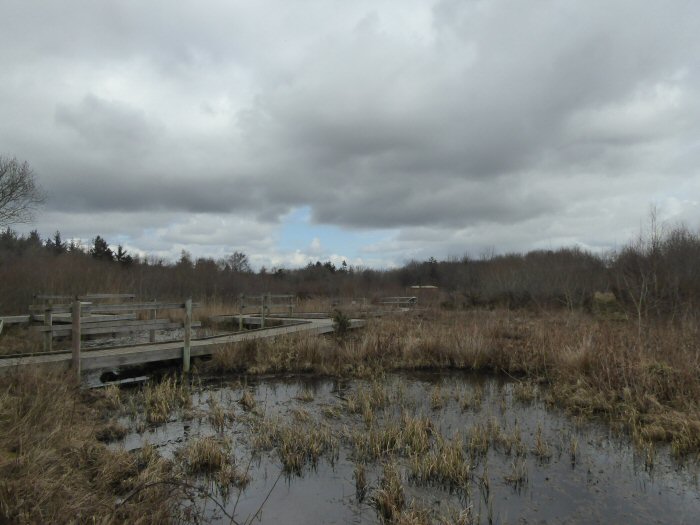
After rain overnight it was a time to photograph a water droplet, which takes you into another upside down little world. Unseen, a spider must be hiding, as a strand of silk is attached right at the tip on the bud.

The 'wrong way up' shows the footpath, stems of willow and the grass.
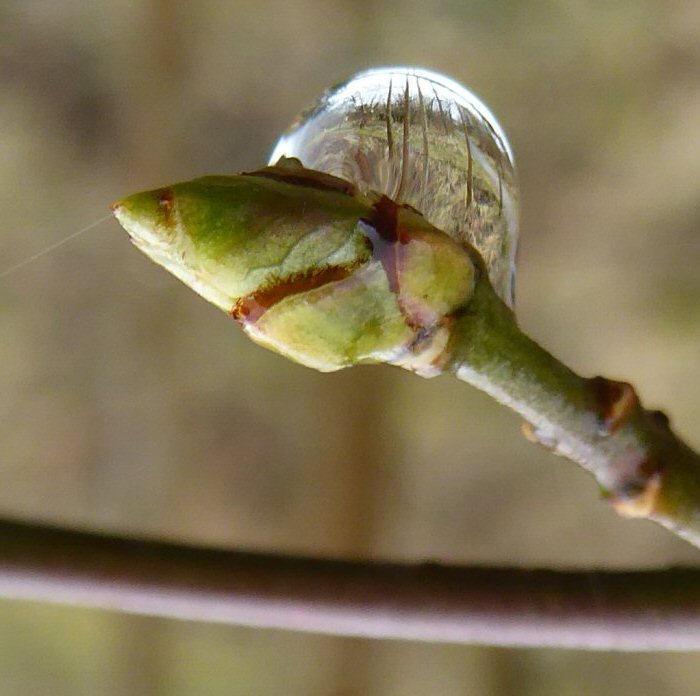
Primroses were also covered in water droplets.

It was a busy day as old nets were replaced and the poles returned to the correct places after the work on the net rides. There were over 130 birds processed. As usual at this time of year most birds were retraps. A Long-tailed Tit was ringed as an adult in 2015 making it at least 2 year old. A Chaffinch was first ringed as a juvenile in October 2012.
Chaffinches are beginning to swell the numbers in the back garden and one caught today was, to say the least, fat. Upon investigation it was found to have built up fat layers, so it was most likely heading back to the continent to breed.

Bramblings are still being recorded but as yet no Chiffchaffs. Coal Tits are flooding back into the reserve ready for the breeding season.
Thank you to everyone who helped today.
Nest boxes of the MoD Training Estate
Friday, March 23rd 2018
I had a great day jumping becks, streams and fences in search of nest boxes to repair, renovate and replace.
First on my list of boxes in need of attention was at Hudswell Grange, which bore signs of vandalism by Woodpecker and was quickly replaced with a woodcrete nest box.
.jpg)
On my way back I took a little time to admire an ancient and neglected hedge and ditch that once marked a land boundary.

Next I followed Badger Beck downstream through the woods to find two more damaged nest boxes. This time the perpetrators were wasps and the elements, and after a little while emptying the boxes and getting them re-secured to the trees I was on my way back to the car and heading towards High Insque.
The box in question at High Insque was one that me and Jenny picked up a couple of weeks ago which came back to have the lid repaired. It's location is especially interesting having been fixed to the side of one of two fallen trees at the edge of the wood that were undoubtedly brought down by high winds.

After High Insque I headed over to the steep slopes of High Spring Wood to replace two boxes, clean out another and relabel the fourth.
Traversing the slopes proved quite difficult when carrying a ladder two woodcrete boxes and a whole heap of tools by myself, however it was all worth it for the impressive views over Downholme and across to Marske in the distance.

After a quick stop off at Stop Bridge Lane to look at another couple of boxes it was time to head back to Foxglove where I was treated to a good sized murmuration on the Wathgill Road.

I had forgotten the incredible noise of hundreds of wings beating just overhead, what a treat!
.jpg)
All in all it has been a cracking day, tiring but well worth it! On my travels I've seen all manner of birds, beasts and plants; from Curlew at High Insque, to Primrose and Roe Deer in High Spring Wood, along with countless interesting veteran trees.
Net ride management 2017/18
Thursday, March 22nd 2018
Net rides again folks!
Over the last few volunteer days we finished tidying up net ride 34 and proceeded to cut net ride 38; today was all about tidying up our mess from yesterday.

It's essential that we take the time to periodically tidy up the net rides. If left they cease to function in the way in which they are intended to, with birds skirting over the top of the mist nets and evading capture.
Bringing down the height of the surrounding vegetation reduces the chance of this happening and enables the bird ringers to do their thing.
Changes between years in the totals of adults captured provide an index of population change at the study sites. Information on post-fledging productivity is provided by the ratio of juveniles to adults captured in the late season; while between-year retraps provide information on survival.
As most sites will be in specified habitats, relationships between habitat and population changes can also be investigated.

Net ride 38 is easily missed, being hidden away adjacent to the heath; and yet as part of the Constant Effort Site (CES) Scheme it is an integral part of our current phase of net ride management (click here for more information about the CES Scheme).

The vegetation adjacent to the net ride is pollarded (cut) on either side to a depth of 2 meters and at the approximate height of a mist net pole.

Excess brash is burnt with suitable timber being left as habitat and often added to habitat piles created at the time of the last net ride cut.

We are now fast approaching the end of the month and the end of this year's window for net ride management. In the coming months we will begin putting together a mangement plan that will include directives for managing the net rides on a rotational basis.

And here it is, the plan which we have been working to over the last few months (and which I have blabbed on about). Those highlighted in blue are those CES scheme rides which we will now leave until next year (due to them not being of pressing concern).
We've completed all of those highlighted in green this year, which includes all other CES scheme rides (except number 38 which is highlighted in red and will be finished presently), along with the two non CES scheme rides at 18 and 19.
Officially Spring!
Wednesday, March 21st 2018
Not only is it the Met Office spring, it is also the spring equinox spring! So before setting out for our walk we wrapped up well with hats, scarves and gloves and wellies! We crunched across some ice and marvelled at the ice covering some parts of the ponds. But to cheer us on our way, there was blue sky and the sun was out! In the centre of the reserve we were sheltered from the brisk, cold, very, west wind. Out on the moor it was a different matter.
We were looking for flowers. Primroses and a Barren Strawberry flower had withstood their snow cover well. Daisies in the sunshine were open. Although we searched and searched our flower list did not grow much longer. We did debate whether we should count every Gorse bush in flower. But perseverance paid off and we found the male flowers of Larch and a Goat Willow tree with its buds well burst.
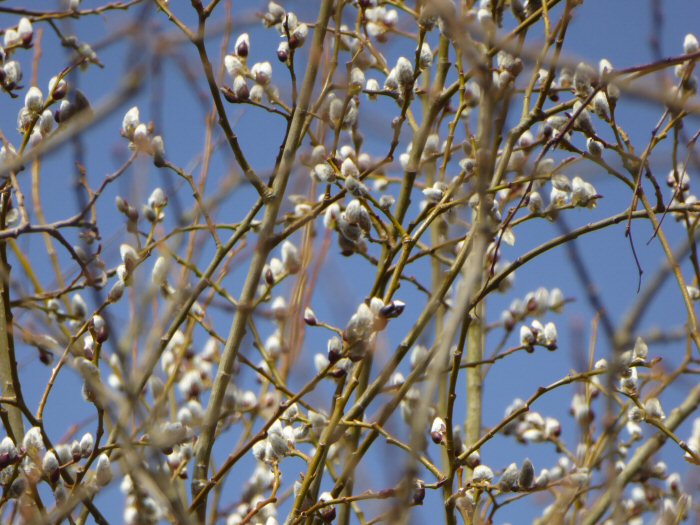
The lake was busy with plenty of Mallard and Moorhen. Greylag Geese were flying over, heading to the wetland.

Birds were feeding well in the back garden. Great Tits, Blue Tits, Coal Tits, Dunnock, Long-tailed Tits and Chaffinch were all to be seen. Then a surprise, a Blackbird was feeding from the feeders. The photograph, taken through the window is not very good but you can definitely see that it is a Blackbird on the feeder!

By the time we left the clouds had gathered but there was just a hint of brightness.

Tree Thinning Completed
Tuesday, March 20th 2018
Work on thinning one area of young woodland has been completed today with four volunteers working to reduce the competition from Birch, Bramble and Gorse to allow the trees planted in this area to get ahead. We also had Colin in to top up the bird feeders around the Field Centre garden and the ones located near to the hides by the Lake and Wetland.

Accompanied occasionally by the calls of both Mallard and Greylag Geese that were flying by, the thinning involved selecting the best examples from the young growth of Alder, Hawthorn and some of the Birch and Willow, while making sure that there is enough light and room for the Oak, Rowan and Blackthorn in this area to develop further to provide future woodland habitat.

Several of the planted trees are in tree tubes and over half of these had broken stakes which were replaced. One tree had outgrown its tube, splitting it at the top of the tube. This could cause further damage to the tree with the sharp edge of the collar of the tube rubbing into the bark so the tube was removed and a new stake and tree tie fitted. We were joined for part of the morning by the regular group from the Dales School who visit the Reserve on Tuesdays, who helped move the cuttings to the bonfire.
Thanks to the small group of volunteers who finished this task today, which will make a considerable difference to this area of woodland in the future.
The Effects of Snow and Ice
Monday, March 19th 2018
The second spell of cold weather is now gradually passing, the thin layer of snow is melting and things are warming up. Lark and Taurus both seemed pleased to feel the warmth of the sunshine this morning as they were given some hay. The effect of the freezing weather has held back some growth but has also created a couple of jobs to do to make sure that the flow of water through the Reserve is maintained.

There are several ponds which are fed from larger becks that flow through the Reserve. The best way of doing this is to dam the watercourse and use pipes to feed the ponds. In one case the pond is still being fed as the water held behind the dam remains at the height of the wood, but the effect of the frost has been to prize the timber apart so that the water no longer flows over the top of the dam but through it.

A larger dam that shows the full effect of the weight of water from recent rain and meltwater is in Risedale Beck and a blog back in October featured a group of volunteers rebuilding part of this. Last week water was at least 30 centimetres above the dam but that has been enough to dislodge the stones in the middle of it. The feeder pipe is still functioning and we can use this as a good opportunity to remove the silt and stones that have built up around the lower half of the pipe.


One quick job this afternoon has been to give some of the smaller Larch trees some care and attention. They have been given new rubber tree ties which reduce the pressure put on the tree and which can be adjusted as the tree grows. Replacing these ties was all done under the watchful gaze of a Roe Buck who continued to browse around 50 metres away while the work took place.
We had a problem receiving emails at the end of last week which thankfully was resolved over the weekend, and we'd like to thank everyone for their patience during this period before we regained connection to the wider world.
Birds with a Twist
Sunday, March 18th 2018
Last week I mentioned going shopping for our fund raising over Easter. I can now give more details. There are three owls that need a name. Grumpy Wise Owl with hat and scarf, Mischievous Owl with big eyes and Sleepy Little Owl. There will be a list of names for each owl and for a £1 you can choose a name. The winning names will be announced after the holidays.

Also mentioned last week was the nest box season. There is still time to Adopt-a-Box for this breeding season. There are details about the scheme on the Support Us page on the web site or in a leaflet available in the Field Centre. A display about the nest boxes will be on show in the Field Centre from Wednesday, along with Guess the Name of the Owl.
There are various boxes available for different species. Some birds like to make alterations to make the box just right for them. A Nuthatch has made the hole smaller by adding mud to the opening.
.jpg)
Blue Tits often use the boxes,
.jpg)
as do Coal Tits.

And another one of my wandering thoughts when I looked at these photos, taken by a drone flying high over the reserve, was that some of our birds must also have this bird's eye view. This is the Stone Circle on the far moor, in summer!

The wetland can really be appreciated when seen from above.
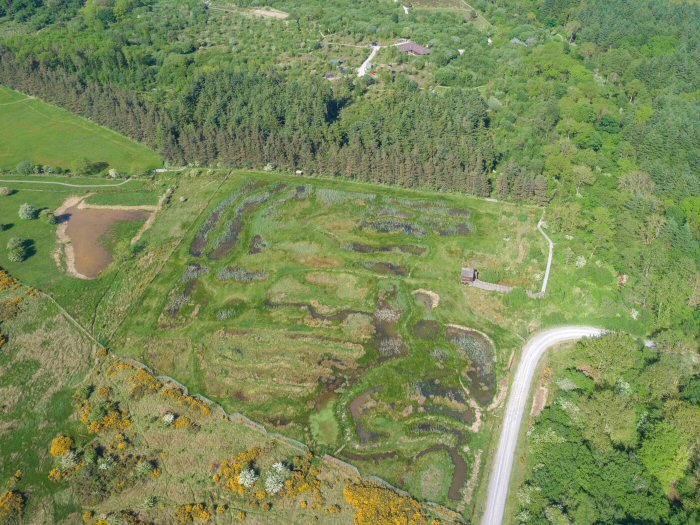
Yet More Species
Saturday, March 17th 2018
Last year was a bumper year for recording new species, 65 in all. Already we have added Little Egret and the White-legged Snake Millipede this year. Another fungus has also been noted, Rusty Porecrust, found growing on the underside of bark of a fallen tree. A good start to our species year.
There are also two species that we are going to check in the late summer as we want confirmation that our ID, from photographs, is correct. Taphrina padi is a fungus that induces a gall on the fruits of Bird Cherry, whilst Taphrina pruni is the gall that forms on Blackthorn berries.
Looking through the records we came across the moth Plain Clay. On checking the ID with C Fletcher, the VC65 Moth recorder, his reply was as follows - 'It’s surprising that it’s never been caught before at Foxglove though you’re right at the north part of the range. I enclose a map showing you how your record fits into the known range.'

Reported larval food plants include Primrose, Cowslip, Common and Sheep's Sorrel, Common Nettle and stitchworts. It is a rather distinctive looking moth.
.jpg)
Our Species List, notes and our photographic records give us indications of the changes through the years. No two years are the same. Our wanderings on Wednesday had us searching for Coltsfoot, to no avail. Last year, it was recorded on 15th March.
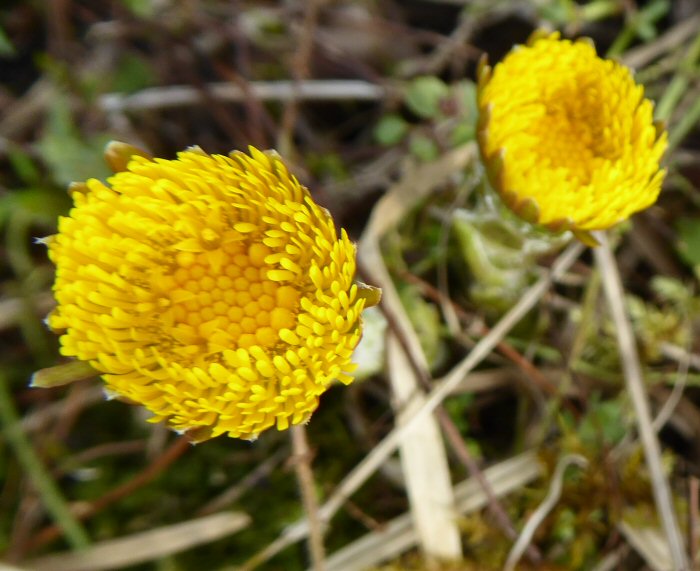
Along with Celandine, correctly called Lesser Celandine.
.jpg)
With snow forecast for the weekend and low night temperatures for at least the next week we are going to have to be patient before we see the return of the spring flora.
Searching for some summer photos did have my thoughts wandering, yet again, to sunshine and warm temperatures. Zig-zag Clover is a good feeding station for bees.
.jpg)
Foxgloves stand tall across the reserve and provide food for many insects, particularly the bees. It still amazes me that each flower has a different pattern of dots.

Carefully hidden away under leaves the Cucumber Spider is one of my many favourites, green with a red bottom!
.jpg)
Another Wet Day
Friday, March 16th 2018
The wet weather of yesterday has continued throughout today and, while there has been the chance to do a number of small jobs such as making sure that the ties on three Juniper trees next to the Heathland were properly secured and cutting back where Birch and Willow branches had been damaged, a priority has been to keep drains clear so that water can flow under footpath surfaces or maintain the flow of water to smaller ponds.

The amount of water flowing through Foxglove today has been very impressive and Risedale Bank has been at its highest for some time. The dams created to help feed the valley's ponds were almost undetectable below the surface with the tree lying across the beck, which is normally at least 30 centimetres above the river, being regularly lapped by waves going downstream. The pipes taking the water from the pond which had the liner removed last Saturday had become blocked and the water was instead flooding across the path. Clearing this was straightforward and the levels in the drain and the pond dropped quickly. This was the first of many similar jobs.

The Willow Spiling in the beck has been tested yesterday and today and is providing excellent protection for the river bank. One task later this year will be to extend this further downstream along the bank.

A different form of protection are the Mink rafts that are strategically placed around the Reserve. Our population of Water Voles are important both for biodiversity and the interest they generate from visitors. Their numbers nationally have dropped dramatically with predation by American Mink being one contributory factor. The Mink rafts are our first line of defence. These animals are incredibly curious and seem unable to resist looking into holes. The rafts are tied in place to float on the water and provide a tunnel with a cartidge of clay which will have the imprint of the feet of animals that walk through. This will let us know if American Mink are around.

One casualty of the recent heavy rain and meltwater has been one of the rafts. While the wooden structure has been able to cope with the increased volume of water, the increased power of the flow has ripped out the clay cartridge which is unlikely to be recovered. We will be replacing this quickly to maintain our defence for the Water Voles.
You say transitional zones, I say ecotones
Thursday, March 15th 2018
The weather has been rotten today, and yet the reserve is ever active. I was especially pleased to be handed this lovely White-legged Snake Millipede found in the Field Centre Activity Room.

Aside from our many legged friend we've also been visited by four Greylag Geese on the Wetland.
The largest numbers of Greylag recoveries are from those ringed in Denmark, Britain and Sweden. The recoveries reported during winter are found in western and southern Europe, in northern Africa and a few in the area of the Black and Caspian Seas.

In terms of habitat management, we have been tackling the scrub by the welcome signs to the reserve along the main access route.

Scrub makes for great habitat when managed properly, with the best results being seen when management is carried out on a rotational basis providing a mix of young and mature scrub. This ensures greater structural diversity which appeals to a wider variety of species.

Once on top of the work scrub management is best carried out at low intensity at regular intervals rather than major works every few years.
It is important to marry management practices with reserve aesthetics and protection of key species; such as the nearby young Oak and Yew that were starting to become crowded out by encroaching scrub.

It is a difficult balancing act that we must carry out; without management of scrub and woodland edge many species that thrive in ecotones where two different habitats meet would soon disappear.
Volunteers at Work
Wednesday, March 14th 2018
The moth trap was empty, not a single moth, so it was on with the next task. This involved filing the photos we use for display.
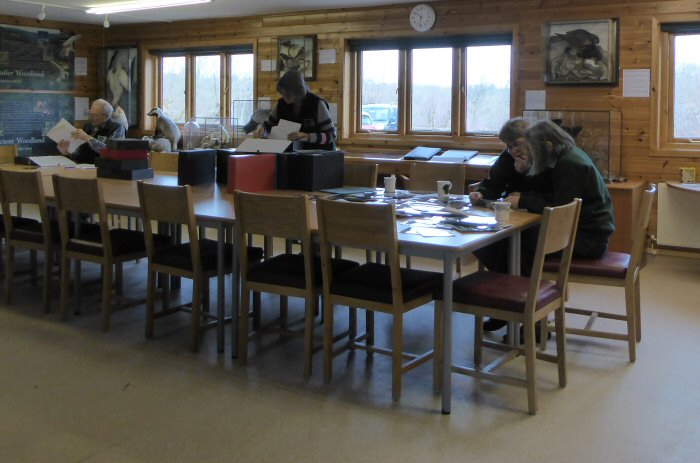
We like to write the names of the species photographed on the back of the photo. Some were easy, others required a little bit of confirmation.
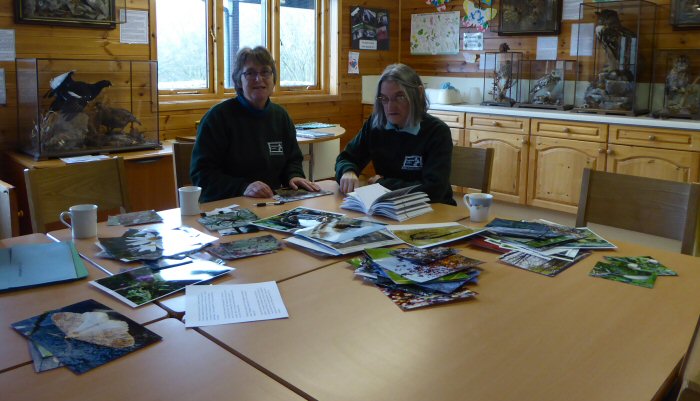
Task completed, lunch was taken and then the sun came out so a walk was called. The Frogs were still busy in some of the ponds but as soon as we approached most disappeared under water.
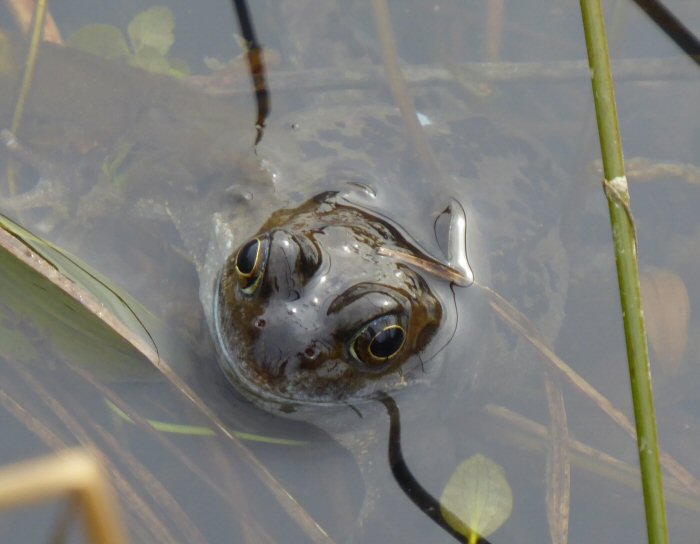
Primroses are coming out all along Risedale Beck.

Some fungi were collected and taken back to the Field Centre for identification.
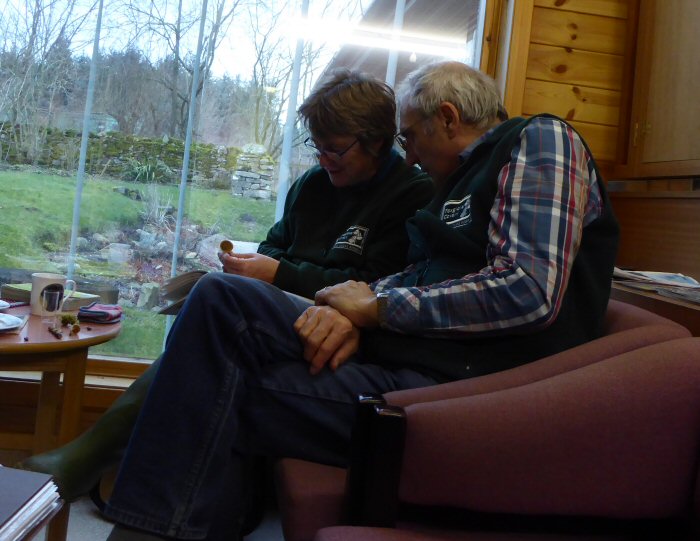
Winter is still holding its grip on the reserve so colour, bugs, beasties and creepy crawlies are in very short supply, so anything different stands out.
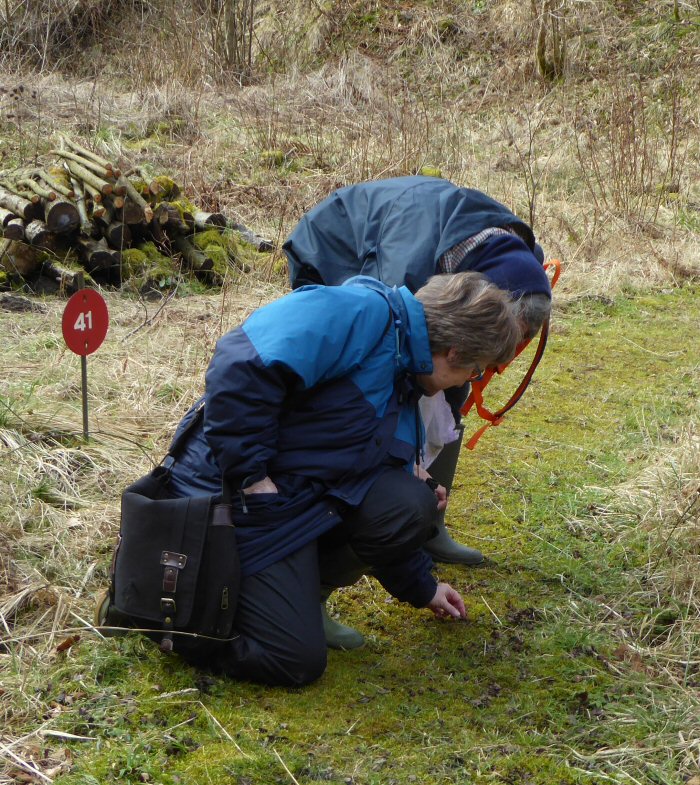
We examined the open hard outer case of Hawthorn berries. Some were still surrounded by the juicy outer layer. Deciding that they had not been eaten by mice or voles as we could find no teeth marks, Grey Squirrel seemed most likely. However the books also said that Hawfinch could also crack these fruits in half from top to bottom. After discussion we disappointedly decided it was Grey Squirrel.

Thank you to everyone who helped today.
Accumulating Amphibians
Tuesday, March 13th 2018
The frogs are finally spawning, with numerous clusters found in the Scrapes, Wetland, and the ponds along Risedale Beck.
Although delayed due to the low temperatures we have experienced of late, night time temperatures have risen such that amphibians across the reserve are now starting to emerge from hibernation.
We're not the only ones to be excited by their return, with the Heron over on the Wetland being especially enthused!

Today we started on net rides 32, 33 and 34; finishing vegetation clearance on all three rides, and completing brash clearance on 32 and 33 before calling it a day.

This leaves us with brash to clear up on net ride 34 this Thursday before I start to clear the next couple of rides this coming Sunday and Monday.
Wet!
Monday, March 12th 2018
Words to describe today kept flitting through my head, amazing, fascinating, exhilarating, uplifting, beautiful, brilliant, but it all boils down to being plain and simply wet, in fact very wet! Small pools were joining up and becoming bigger pools and then overflowing across the paths. Small becks, sometimes empty of water, were full and noisily rushing off the moor.
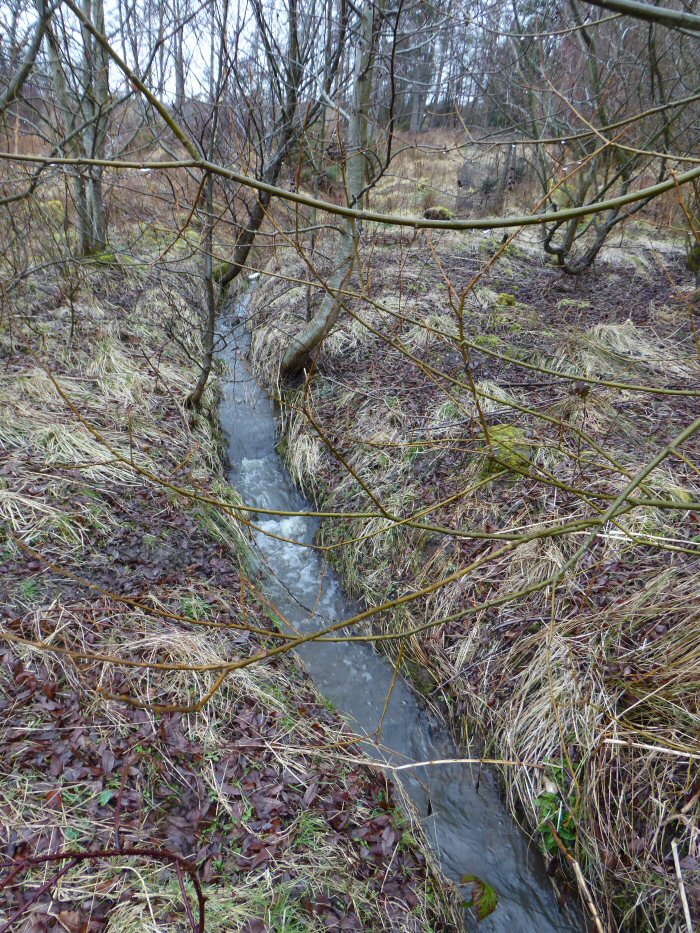
Where two streams meet it was white water!
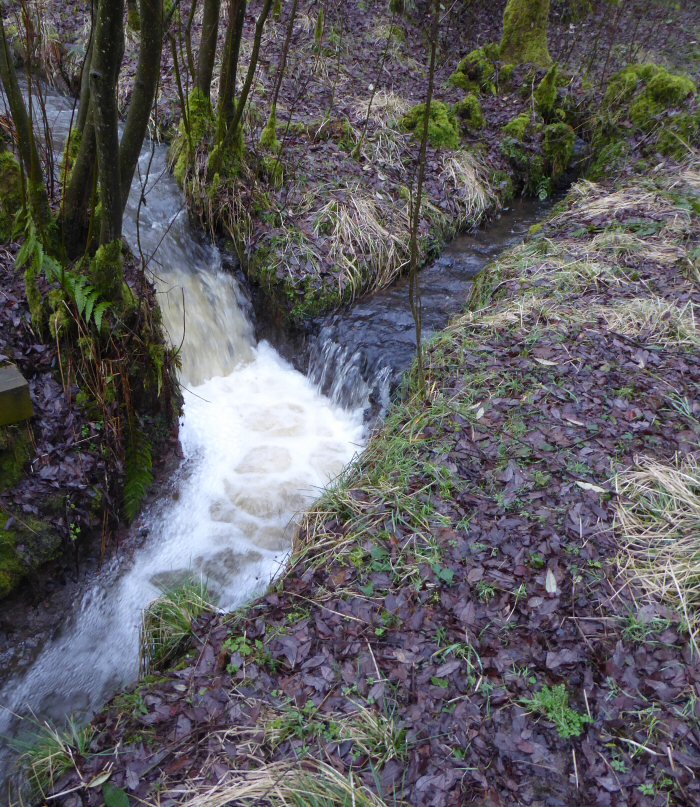
Despite the wet, it was not cold so walking through the Scrapes I tried to listen for Frogs calling, despite the drops of rain falling all around, but it proved a fruitless exercise. The water in the ponds was almost boiling with the rain drops when I noticed in a sheltered bay, some ripples that were not rain drop ripples! A stealthy approach saw the water become almost smooth, no Frogs but I was lucky enough to find the frogspawn, probably 24 to 48 hours old.

The cascading ponds were certainly living up to their name. I did not think a diversion off the main path to check for spawn was a good idea.
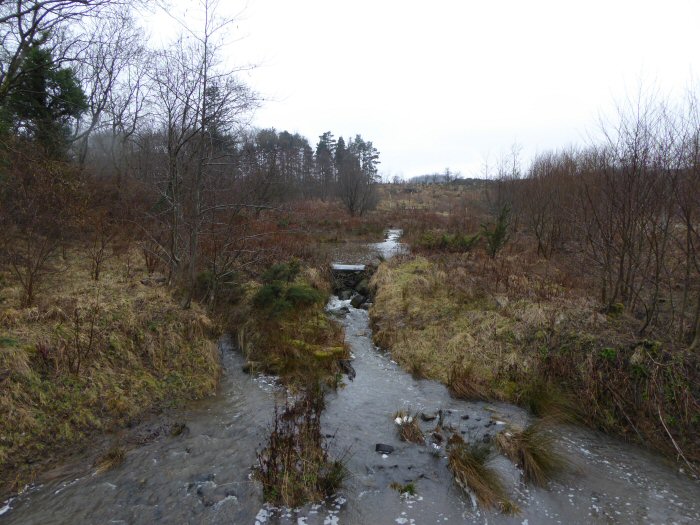
However there are times even when it is wet that there is beauty around you, in this case, water droplets on Hazel catkins.
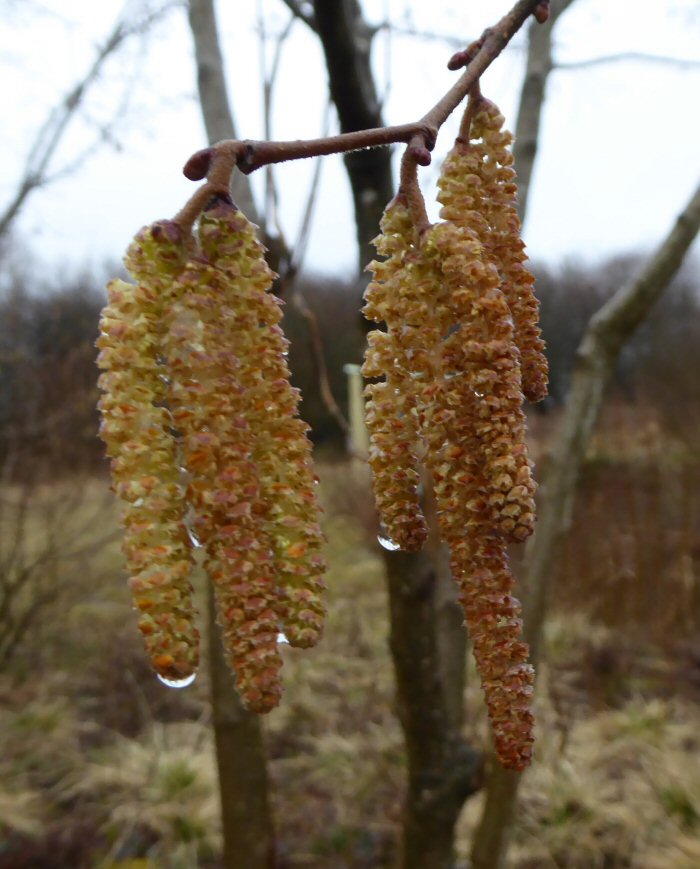
Linking Thoughts
Sunday, March 11th 2018
I went shopping yesterday for something specific for our fund raising coming up to Easter, and was successful. Working on this little project, made my thoughts turn to the nest box season. (Apologies you will have to wait a little longer for more details.)
Over winter, as has been reported on the blog, the nest boxes have been repaired or replaced. The first boxes to be checked are those of the Tawny Owls. Sometimes the adult birds can be caught at the box.
There is often quite a variation between boxes. Some will still have eggs whilst others will have all the eggs hatched.
.jpg)
As the chicks grow so they become more curious.

Foxglove has its own owl boxes but there are many spread across the training area and whilst out there in early spring, and often quite cool temperatures the weather gives a spectacular display. Rainbows.

Sunset.

Forbidding cloud.
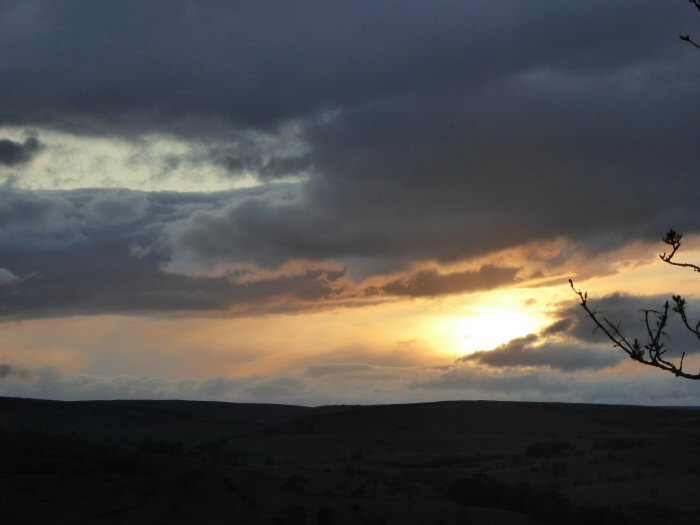
Which then drew my thoughts to early mornings and the first CES in May. Hopefully there will be some sunny sunrises!
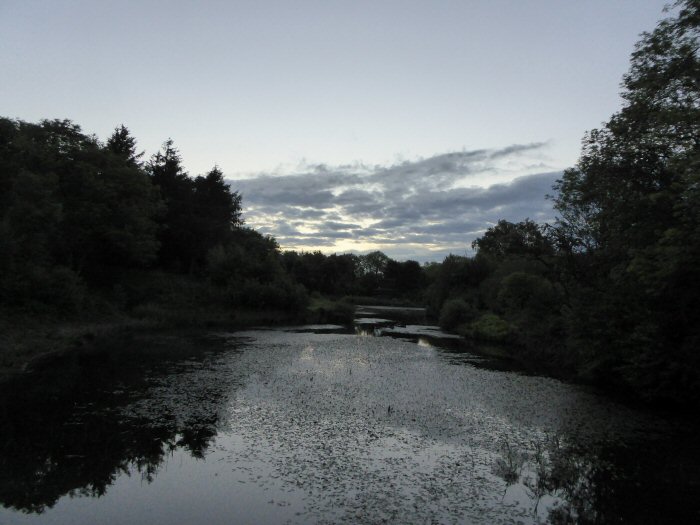
Amazing how one thought links to the next!
March Winter Worky Day
Saturday, March 10th 2018
The final Worky Day for the season took place today having been postponed from last week due to the heavy snow. The weather wasn't much better at the start of the day as heavy rain had been falling during the early hours and hadn't really stopped as the volunteers arrived. There was still a good turnout with 13 volunteers working through the rain. Thankfully, this gradually cleared to leave grey but dry skies.

Work continues on the net rides and the group made light work of removing the rest of the cut material from rides 30 and 31, which was taken away to be burnt at the Bullet Catcher site. Having a fire in the rides would have been difficult as the heat could affect the trees, with burn sites having to be selected carefully.

Work was also quickly completed in net ride 39, which was chosen because of the hard surface through the ride. Two people worked on cutting the ride while the rest pulled the material clear and cut it up further for the bonfire.

Another priority job was to remove a plastic liner from a small pond in Risedale Beck. The liner had outlived its useful life and was damaged in a number of places. It was also changing the nature of the pond from one to hold water when there is heavy rain so that it can drain into the beck more slowly to one with standing water all the time.

After two drainage channels had been cut to allow some of the water to drain away, the liner was gradually pulled clear of the water and rolled up to be taken away. Doing this and leaving the drainage channels will mean that this will revert back to a wet area which occasionally has water rather than a permanent pond.

A very big thank you to all the volunteers who braved the weather and achieved so much today, and to those who have come along to the previous Worky Days over the autumn and winter. Your efforts have made a significant contribution to managing the Reserve.
A Siskin Day?
Friday, March 9th 2018
Some of the bird ringing team were in for a morning's ringing. The aim, to catch some of the many Siskin that had been seen at the back garden feeders throughout the week. Some Redpoll would also have been welcome. Nature does not always read the same page as we do, so needless to say it was Redpoll none, Siskin one! However there were other birds caught, including a Great Tit that had been ringed in the nest box in May 2014 and a Robin initially ringed as a juvenile in July 2015.
Greenfinch numbers have been low and so it is always a pleasure to catch one. I should not make comment on the look of the bird, but its stare made me think that it was pretending to be a Sparrowhawk, with those two bright eyes looking straight at me.
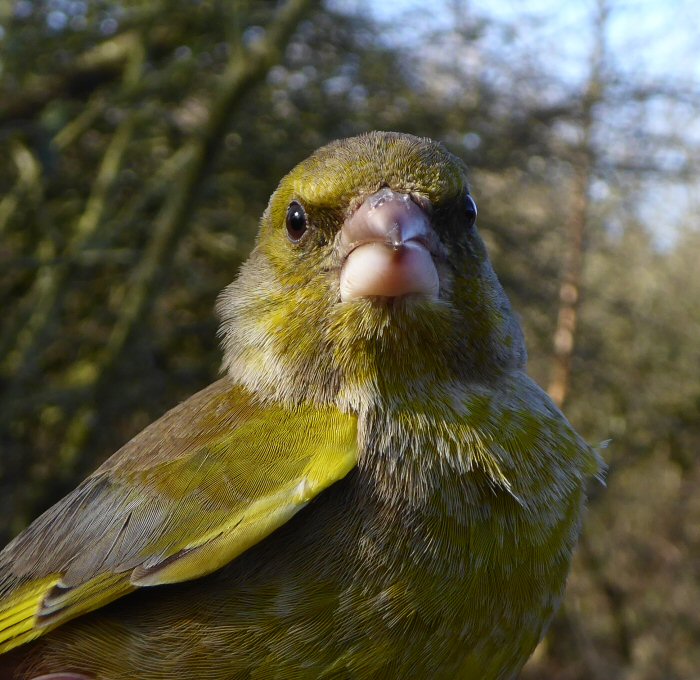
Lottis have been flitting in and out of the garden so it was no surprise that we caught two. Usually when we photograph these birds we only manage to get the head but today this one sat with its tail at just the right angle.
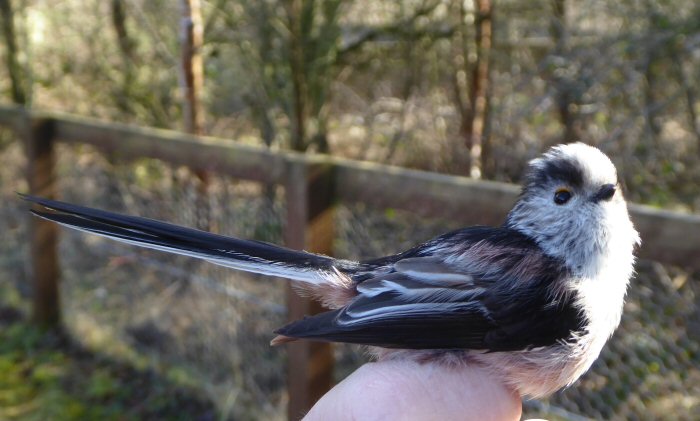
Blackbirds have also been busy feeding in the back garden and this young male received its ring. It was hatched last year, and one of the pointers to this was the fact that it still had some brown colour on the top of its yellow beak, along with some mud.

Althought the temperature reached double figures it was very cold initially with frost catching some of the vegetation. This moss was ice covered.
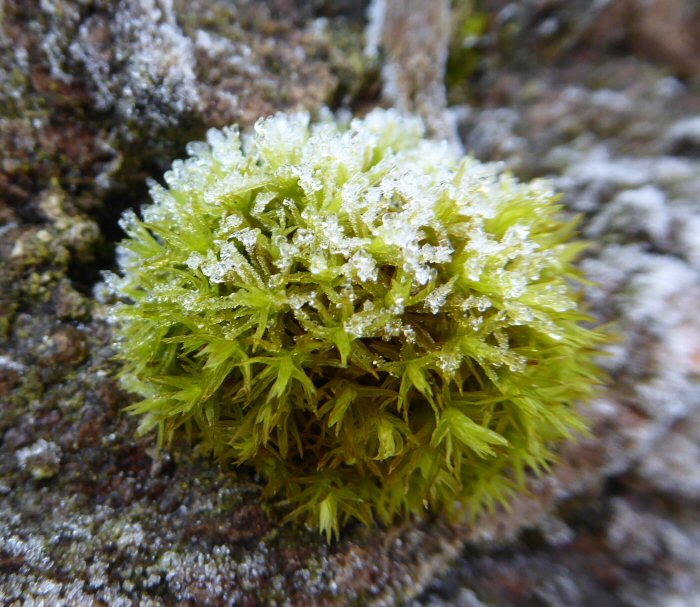
I was amazed to see that this piece of ice, if you could call it a piece, was still hanging over an open space, defying gravity.
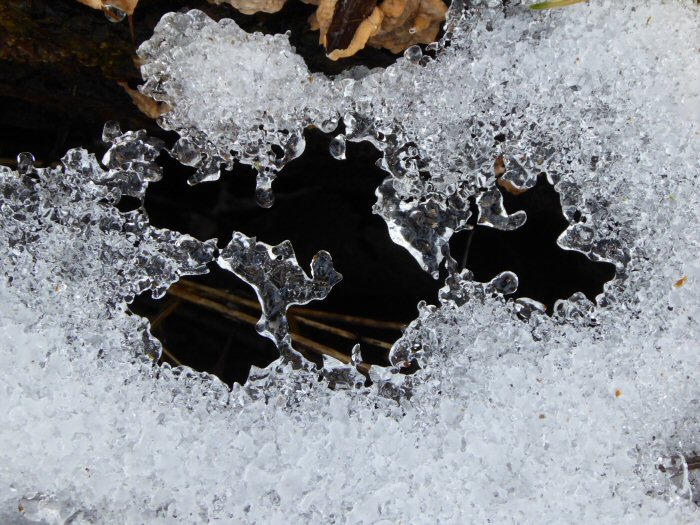
And finally a piece of fun - how about a game of noughts and crosses?

And a second finally, thank you to all the volunteers who assisted with various jobs including filling feeders, ringing and habitat management.
Bullet catcher clear up
Thursday, March 8th 2018
It has been a glorious day on the reserve today, quite the contrast from the weather we were experiencing last week.

One benefit of this has been the increase in Water Vole activity, with plenty of evidence of them down on the Scrapes.

As yet we are waiting for the first photograph of a Water Vole this year, so we will have to make do with one taken last year.

We have spent the whole day tidying and scheming down at the bullet catcher after the winter.
Thank you to everyone who helped today.
A Wander Around
Wednesday, March 7th 2018
The thaw has really set in and much of the snow has melted, but turning the corner every so often, snow was still to be found.

Although I was told I was being pessimisitc, the old wives tale 'if there is still snow in the hedge back, then there is more to come', did cross my mind.
Although the reserve is still in the grip of winter there is life around. Birdsong could be heard as we walked around, from Great Tit to Mallard and Buzzard to Greylag Geese. Two Greylags were spotted on the lake.

The male Mallards are in full breeding plumage and their green heads are iridescent. These two were on the area where food is spread for the waterfowl. You can just see the female hidden behind the vegetation.
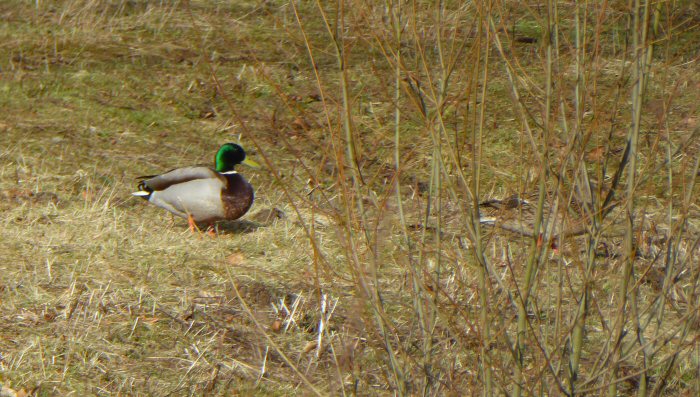
This male was alone and although I looked for a female, her camouflage was too good for me to pick her out amongst the reeds.
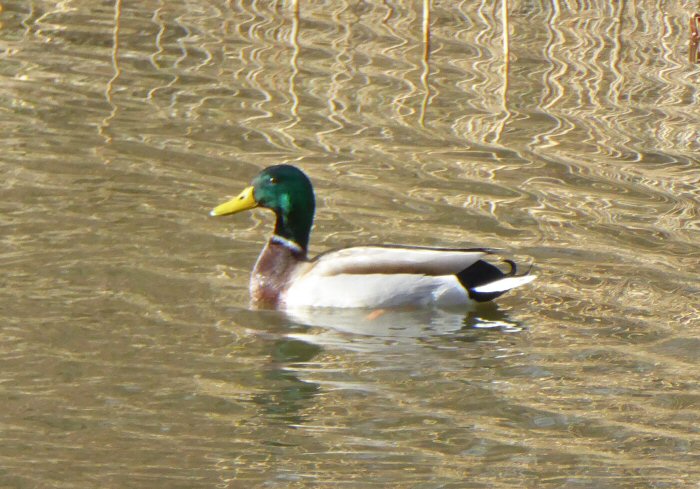
Feeders in the back garden were busy with Siskin, Redpoll, Long-tailed Tits, Great Spotted Woodepecker, Bullfinch and Blackbirds, to name just a few. It was mentioned that the Fieldfares had cleared a tree near the Voley Pond of berries at the weekend. They have also removed every berry off the Holly on the moor.
Lapwing and Grey Heron were seen flying across the moor.
Leaves of Greater Stitchwort, Lesser Celandine and Nettle are just beginning to show. Primroses have withstood the snow, and hiding behind one clump was a flower of Barren Strawberry.
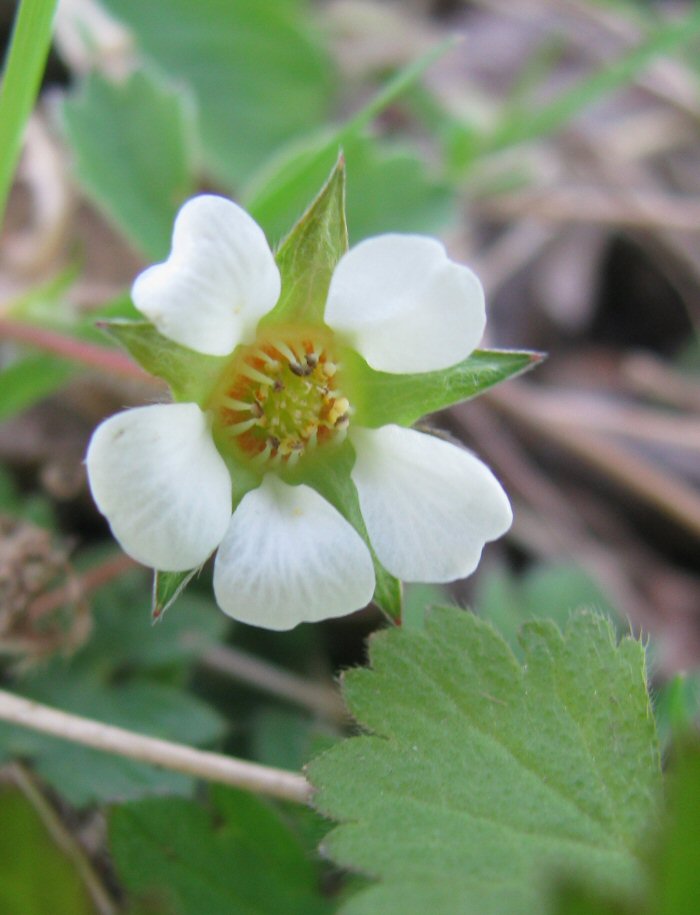
Another flower that opens its buds at this time of year is Opposite-leaved Golden Saxifrage. The first flowers are seen along the beck running from the Voley Pond. If the weather stays not cold then soon the banks will be yellow.

Waiting in the wings are the buds of Blackthorn.
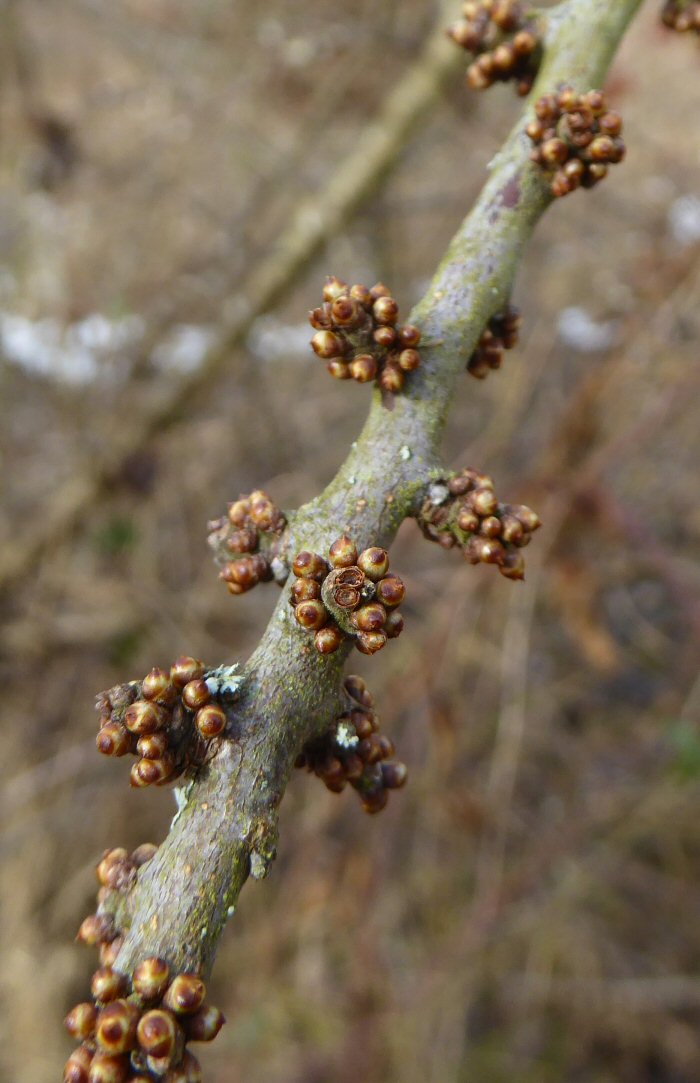
Vistas are different when the leaves are not on the trees and the Stone Circle could be seen from the path near the head of the lake.

Three Spined Sticklebacks were recorded in the ponds but as yet no Frog activity. More species were added to the Observation Board back in the Field Centre. Thank you to everyone who helped today, to wander around.
Clearing net rides 30 and 31
Tuesday, March 6th 2018
The objective of today's volunteer task was to clear the brash from net rides 30 and 31, and transport it down to the bullet catcher to be burnt.

We were joined by the Dales School just before lunch, who enjoyed helping us fill a trailer load and also helped cut the brash to length ready for the next stage.

Although we really went for it, with everyone putting in a shift and a half, we didn't quite manage to clear all of the two rides of brash. However we did manage to get rid of a whole pile of wood down at the bullet catcher, and even started tidying up ready for firewood collections later in the week.

It's likely that Saturday's Worky Day will include removing the last lot of brash from net ride 30, whilst simultaneously cutting two more nearby net rides.
Back on to net rides 30 and 31
Monday, March 5th 2018
While Steve busied himself by making his way through the weekly checklist, filling the feeders and feeding the ponies; the thaw meant that I was finally able to get back to work on net rides 30 and 31.

Aside from the odd bit here and there 30 and 31 are now cut, and ready for the brash to be dragged from the rides as part of tomorrow's volunteer task.

We are still making good progress with the net rides, having cut 9 out of an ambitious 17 that we are aiming to complete before the end of the month.
Net rides 30 and 31 are both British Trust for Ornithology (BTO) Constant Effort Sites (CES) and as such must be maintained to the highest standard. There are a total of 16 CES net rides on the reserve, all which must have nets in operation over the same time period at regular intervals through the breeding season each year.
I had my most interesting couple of hours on the reserve to date on Saturday when myself and Mel came in to see to the ponies. Firstly we were greeted by two ponies that were very happy to see us (as can be seen in this video); and then shortly afterwards we were followed from the Moorland to the Vole Ponds by a flock of Fieldfare, 85 strong who stripped the trees of berries over our heads.
After sitting for a while to watch the Fieldfare the female Sparrowhawk swooped through and took one on the wing, almost spiralling down into the brambles before regaining control and leaving with her prize.
If this wasn't good enough, we were then lucky enough to see a Little Egret on the Lake on our way down to feed the ducks. Little did we know just how special this was, it being the first recorded on the reserve; what a day to forget the camera!
Fabulous Foxglove Finches!
Saturday, March 3rd 2018
From the comfort of the Field Centre it is possible to watch some stunning birds on the feeders. Redpoll are often feeding in flocks around the hopper. This typical male has a lot of red on his breast.
Whilst the juvenile females have a plain buff-coloured breast.
Another colourful finch frequenting the foxglove garden is the Siskin, this male is already sporting his spectacular breeding plumage!
A young female Brambling was also caught and ringed today, it won't be long before these beautiful birds are heading back to their breeding grounds in Scandinavia. Maybe the 'Beast from the East' has delayed their return journeys.
Where else can you watch these incredible birds from a comfy chair in a heated building with a cup of tea or coffee? If you would like to see them for yourselves please take care as the access track to the Field Centre is icy, however, there is plenty of parking space on the parade square. A short ringing session in the garden today produced 51 birds of 10 species in less than 3 hours!
Surviving the Winter
Saturday, March 3rd 2018
Many birds come into Foxglove from the surrounding area and make use of the variety of food provided. As has been stated on the blog, the feeders are being filled regularly in this cold weather. One of our volunteers fills containers with fat and seed, which is really enjoyed by many of the smaller birds, like this Coal Tit and Blue Tit
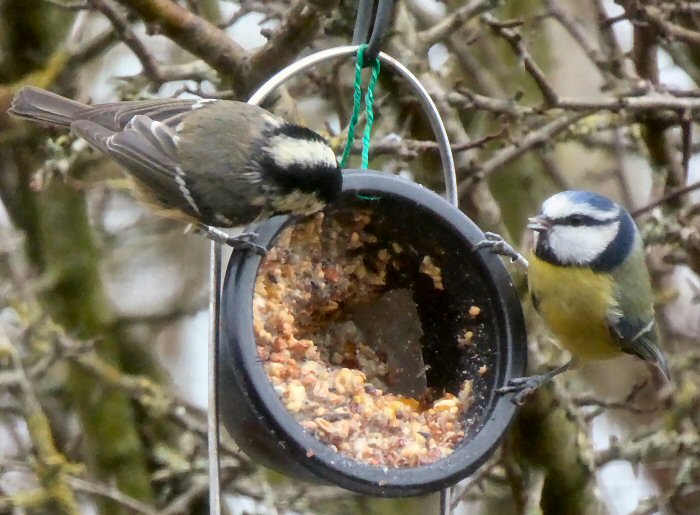
Long-tailed Tits also visit these feeders.

Damselflies and dragonflies survive as larvae in the silt at the bottom of the ponds. Some may spend several years in the larval stage before hatching into adults.

Ladybirds hibernate as adults. Each species likely to favour different places, such as in tree bark or leaf litter.
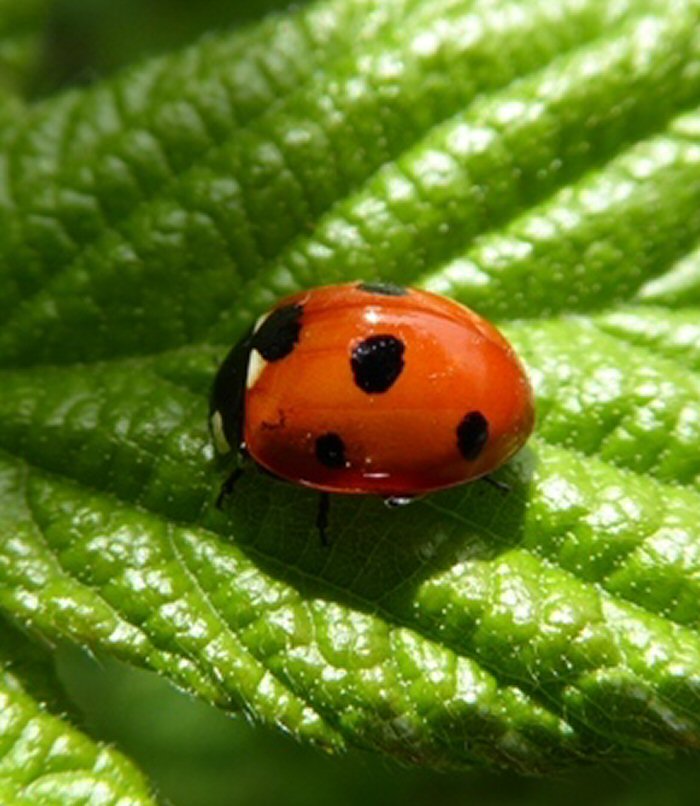
Some butterflies survive winter as eggs or pupa, but Peacock
.jpg)
and Brimstone spend the winter hidden away as adults.
.jpg)
Amphibians have the choice of many of our log piles, or some may even stay in the ponds, whilst others will dig holes or find holes in which to hibernate. Our Common Lizard, another cold blooded animal also hibernates, from October through to March.

Plants also need survival stategies for winter. Deciduous trees drop their leaves. Perennial flowers have underground roots and their leaves may also dies back. Annual flowers produce seed which are dormant until conditions are right for germination. From March onwards, ever hopeful, we start to look for the seedlings of Yellow Rattle across the middle moor.

Feeding our Feathered Friends
Friday, March 2nd 2018
During cold spells it is important to feed the garden birds and by offering a variety of foods you can attract many different species. Goldfinches are becoming more common in urban areas and are often seen at garden feeders especially where there is nyger or black sunflower seed.
Long-tailed Tits, although small, are very fluffy allowing them to trap lots of air amongst their feathers for insulation from the cold. Recent footage on BBC Winterwatch showed a group of these huddled together whilst roosting to keep warm. They enjoy feeding on peanuts and suet.
Less common and being a farmland bird, the Tree Sparrow prefers to feed on red millet although in this weather any seed will do!
Starlings will eat just about anything although their favourite seems to be fat balls and scraps! If you look carefully you can identify males and females with the naked eye as their bills are coloured ready for the breeding season: blue on the males…
and pink on the females! A clear indication that Spring is on its way - somewhere…
Business as usual
Friday, March 2nd 2018
We were greeted this morning by some monstrous icicles hanging from the Field Centre, the largest of which was 153cm!
Unfortunately due to the risk of them damaging the gutters they had to be removed, and have been left on the porch for anyone that wants to have a look at them.

I think it may have been the first day this week where we didn't need to clear the paths around the Field Centre. One thing that hasn't changed however is our regular visits to the Moorland to check up on Lark and Taurus who are doing just fine.

Aside from making sure that the ponies are well fed we've been busy filling up all of the feeders around the reserve in preparation for the weekend, and compiling this year's events calendar. We are hoping to link in with such national and international events as 'Walk in the Woods Month', 'Plant Conservation Day', 'Insect Week', and 'International Bat Night' to name but a few.
The reserve has played host to many bird species today, including Redpoll, Long-Tailed Tits, Rooks, and Siskin around the Field Centre, with the first visit from our female Sparrowhawk in a week too!
We continue to see the two Snipe taking shelter under the boardwalk on our many trips back and forth filling up bird feeders, and have even been graced by an appearance of a large flock of Fieldfare up on the Moorland this afternoon.
Beasts from the East!
Thursday, March 1st 2018
Not all beasts from the East are bad news! Some of our wintering birds come from Scandinavia. This beautiful Redwing was caught and ringed at the weekend by some members of the Swaledale Ringing Group.
Another winter visitor is the Fieldfare which is usually seen feeding in large flocks in open fields. However the extreme weather conditions have encouraged some of these stunning birds to visit gardens.
Similar in size to a Blackbird, these thrushes also enjoy feeding on fallen fruit and Rowan berries and can be attracted to your garden if you leave apples out on the lawn.
This one was caught and ringed this afternoon. It is an adult female and from close up you can see the rusty-yellow or ochre tinge on its breast.
Storm Emma?
Thursday, March 1st 2018
First things first, causing mini blizzards by using the leaf blower to remove snow from the paths around the Field Centre; although highly effective is also a great way of covering yourself in snow too.
.jpg)
Stopped to admire the massive icicles around the Field Centre before topping the bird feeders up and heading over to the Moorland to meet up with Lark and Taurus.

As always the carrots and apples were most welcome by Taurus, whereas Lark was far more sensible and stuck to hay. This was the first of three trips to check on the lads and top up their hay reserves; thankfully they have now taken to sheltering by the top gate onto the Moorland and seem right at home in this kind of weather.

After continuing the bird feed run to include the net ride feeders and hoppers there was time to replace bird box 139 down at Risedale Beck before turning in to warm up and eat lunch.
This particular nest box is one kindly donated to us after our Bird Box building event earlier in the year.

After lunch it was back out towards the wetland hide to fix the door on the owl box by the gate; you really start to feel the wind chill factor when halfway up a tree fiddling with clasps and eyelets with no gloves on!

We decided to go all out later on and stock up some of the feeding stations with expired Army rations.
Down at the Lakeside Bird Bistro 'Bacon, Omelette and Beans' were served up, along with 'Mexican Bean Salad', and for the birds watching their weight 'Tuna in Light Mayonnaise'; all of which went down a treat.

After one last trip to take the ponies more hay we headed home on a day when half of the country seemingly skived off.

.JPG)



.JPG)








